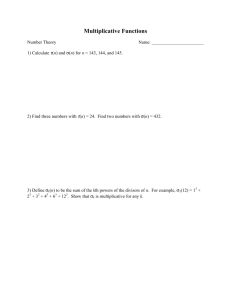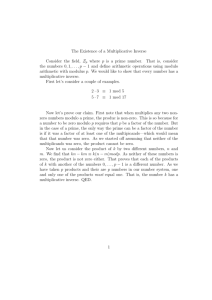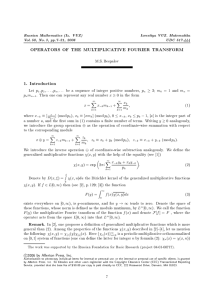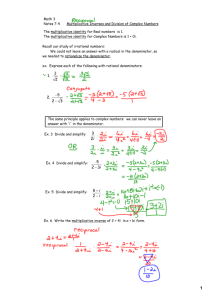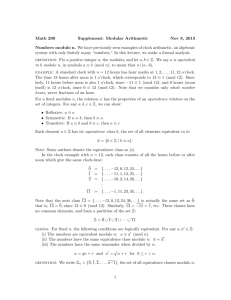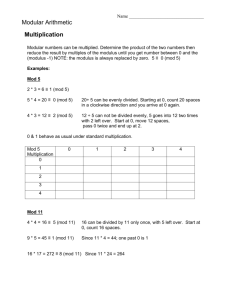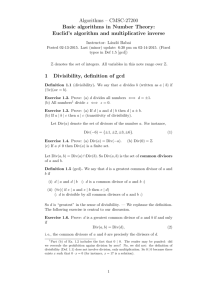Recitation 10 Solutions
advertisement
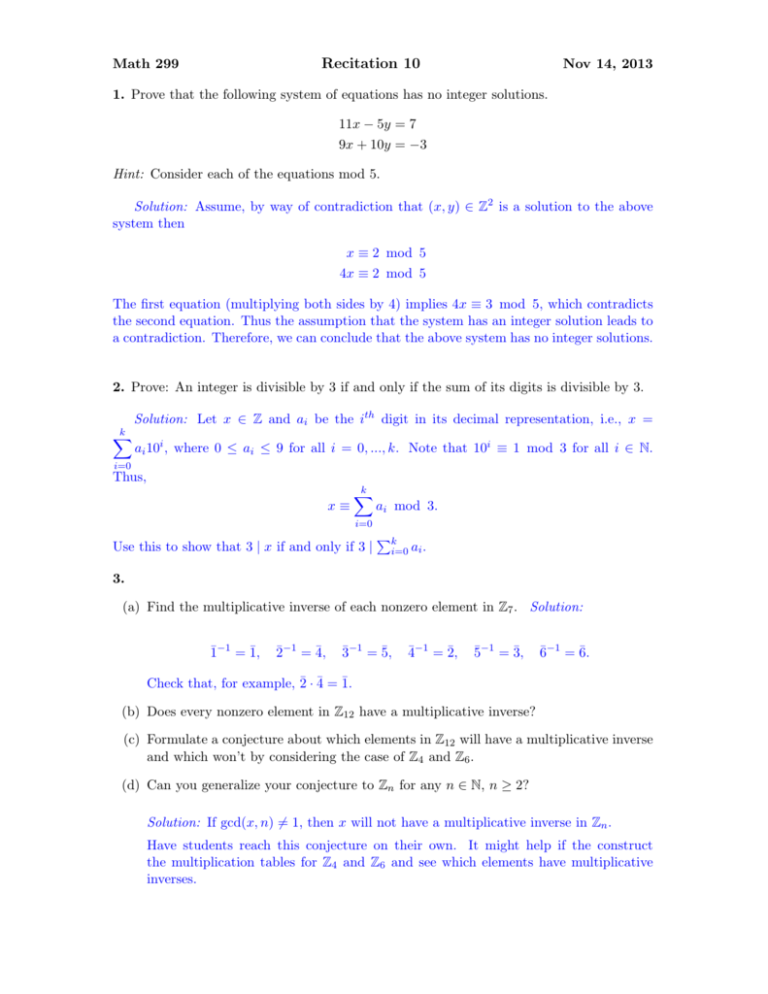
Recitation 10 Math 299 Nov 14, 2013 1. Prove that the following system of equations has no integer solutions. 11x − 5y = 7 9x + 10y = −3 Hint: Consider each of the equations mod 5. Solution: Assume, by way of contradiction that (x, y) ∈ Z2 is a solution to the above system then x ≡ 2 mod 5 4x ≡ 2 mod 5 The first equation (multiplying both sides by 4) implies 4x ≡ 3 mod 5, which contradicts the second equation. Thus the assumption that the system has an integer solution leads to a contradiction. Therefore, we can conclude that the above system has no integer solutions. 2. Prove: An integer is divisible by 3 if and only if the sum of its digits is divisible by 3. Solution: Let x ∈ Z and ai be the ith digit in its decimal representation, i.e., x = k X ai 10i , where 0 ≤ ai ≤ 9 for all i = 0, ..., k. Note that 10i ≡ 1 mod 3 for all i ∈ N. i=0 Thus, x≡ k X ai mod 3. i=0 Use this to show that 3 | x if and only if 3 | Pk i=0 ai . 3. (a) Find the multiplicative inverse of each nonzero element in Z7 . Solution: 1̄−1 = 1̄, 2̄−1 = 4̄, 3̄−1 = 5̄, 4̄−1 = 2̄, 5̄−1 = 3̄, 6̄−1 = 6̄. Check that, for example, 2̄ · 4̄ = 1̄. (b) Does every nonzero element in Z12 have a multiplicative inverse? (c) Formulate a conjecture about which elements in Z12 will have a multiplicative inverse and which won’t by considering the case of Z4 and Z6 . (d) Can you generalize your conjecture to Zn for any n ∈ N, n ≥ 2? Solution: If gcd(x, n) 6= 1, then x will not have a multiplicative inverse in Zn . Have students reach this conjecture on their own. It might help if the construct the multiplication tables for Z4 and Z6 and see which elements have multiplicative inverses. (e) Find the multiplicative inverse of 7 mod 31. (Hint: Use the Euclidean Algorithm to solve 7x + 31y = 1 for integers (x, y)). Solution: 31 = 7 · 4 + 3 7=3·2+1 3=1·3+0 Therefore, going backward, we find 1 = 7 − 2 · 3 = 7 − 2(31 − 7 · 4) = 7 · 9 + 31 · (−2). Thus, 7̄−1 = 9̄. 4. For (a, b), (c, d) ∈ R2 define (a, b) ' (c, d) to mean a2 + b2 = c2 + d2 . Prove that ' is an equivalence relation in R2 , i.e. prove that it satisfies reflexivity, symmetry and transitivity. Solution: Reflexivity: We need to show (a, b) ' (a, b) ∀(a, b) ∈ R2 . This is clear, since it is equivalent to a2 + b2 = a2 + b2 . Symmetry: We need to show that if (a, b) ' (c, d) then (c, d) ' (a, b). This is immediately evident using the definition of ' and the symmetry of “=”. Transitivity: We need to show that if (a, b) ' (c, d) and (c, d) ' (e, f ), then (a, b) ' (e, f ). Assume (a, b) ' (c, d) and (c, d) ' (e, f ), then, by definition, a2 + b2 = c2 + d2 and c2 + d2 = e2 + f 2 . By transitivity of “=” this implies a2 + b2 = e2 + f 2 , which in its turn means that (a, b) ' (e, f ). 5. Let S be a set with an equivalence relation ', and let [a] denote the class of a (sometimes denoted as a). Recall the Theorem: We have [a] = [b] if and only if [a] ∩ [b] 6= ∅. For (a, b), (c, d) ∈ R2 define the equivalence relation (a, b) ' (c, d) by: a2 + b2 = c2 + d2 . √ Use the Theorem to prove: a. [(0, 2)] = [(1, 3)] b. [(0, 2)] ∩ [(1, 1)] = ∅ Solution: √ √ 2 +( 3)2 , therefore, (0, 2) ' (1, 3). By definition of equivalence a. Note that 02 +22 = 1√ √ √ class, this implies that (1, 3) ∈ [(0, 2)]. Thus, (1, 3) ∈ [(0, 2)] ∩ [(1, √ 3)], in particular, √ [(0, 2)] ∩ [(1, 3)] 6= ∅. The above theorem implies that [(0, 2)] = [(1, 3)]. b. Note that 02 + 22 6= 12 + 12 , therefore, (0, 2) (1, 1). By definition of equivalence class, this implies that (1, 1) ∈ / [(0, 2)] and therefore [(0, 2)] 6= [(1, 1)]. The theorem contains a biconditional statement, one of the directions asserts that if [a] ∩ [b] 6= ∅, then [a] = [b]. The contrapositive of this statement is as follows. “If [a] 6= [b], then [a] ∩ [b] = ∅.” Since we have shown that [(0, 2)] 6= [(1, 1)], this implies [(0, 2)] ∩ [(1, 1)] = ∅.

